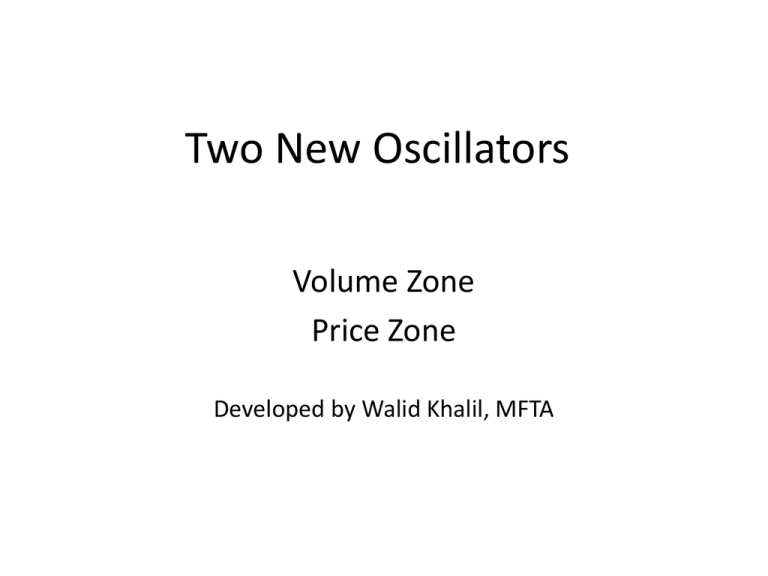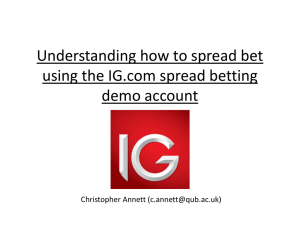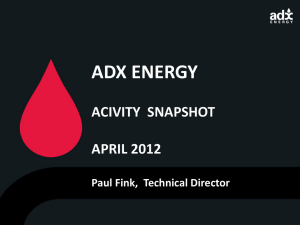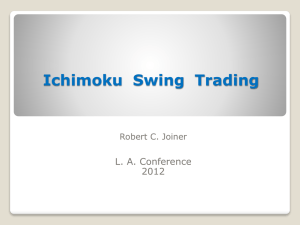Two New Oscillators – Australia David Steckler
advertisement

Two New Oscillators Volume Zone Price Zone Developed by Walid Khalil, MFTA VOLUME • Volume analysis is a key component of analyzing and predicting the future directional behavior of an asset. • Joe Granville and OBV: Add a period's volume when the close is up and subtract the period's volume when the close is down. • Time is not relevant to OBV. Volume Zone Oscillator (VZO) • VZO takes into account both time and volume. • VZO smoothes the volume and plots such actions in the form of an oscillator, not as a trend following indicator like the OBV. • These modifications take the form of a leading indicator that provides buy/sell signals based on oversold/overbought behavior. • Useful in up trending, down trending, and sideways markets. VZO Formula • If today’s closing price is higher than yesterday’s closing price, then the volume will have a positive value (Bullish); otherwise, it will have a negative value (Bearish). PRICE • Price discounts everything. • Determined by the interaction between demand and supply. • When demand increases relative to supply, price goes up, and when demand decreases relative to supply, price goes down. Price Zone Oscillator (PZO) • Useful in up trending, down trending, and sideways markets. • Similar in concept to VZO. Formula: If today’s closing price is higher than yesterday’s closing price then the closing price will have a positive value (Bullish), otherwise it will have a negative value (Bearish). Components of VZO and PZO • 60-period exponential moving average; • 14-period ADX; and • Seven oscillator zones: +60, +40, +15, 0, -5, -40 and -60. Seven Oscillator Zones +60 is marked with green crosses; +40 with a green line; +15 with a gray line; 0 with a black line; -5 with a rose line; -40 with a red line; and -60 with red crosses. VZO Clarifies Money Flow • VZO discerns bullish volume from bearish volume and is useful for identifying at which zone (bullish or bearish) volume is positioned. • The oscillator is plotted on a vertical scale of -100 to +100. • Movements above +40 are considered overbought while an oversold condition would be a move under -40. • Movements above +60 mark extreme overbought levels while an extreme oversold condition is a move under -60. • The zero line demonstrates equilibrium between buyers and sellers. • VZO movements and its money flow analysis also explain Dow Theory’s trend phases of accumulation, public participation, and distribution. This chart shows the four major zones (+60, +40, -40, -60), the two minor zones (+15, -5), plus zero (horizontal black line). System Rules For VZO/PZO • 14-period ADX is the determinant between trending and non-trending (oscillating) price behavior: ADX > 18 = trending ADX < 18 = non-trending • Price < or > 60-period EMA determines whether action is Bearish or Bullish. • When ADX < 18, the relationship between price and EMA is ignored. Up Trend Psychology • “Volume goes with the trend” – Dow Theory as expressed by Edwards and Magee. • Long term investors tend to accumulate shares gradually, leading to a major shift in the demand/supply outcome towards the demand, which in turn leads to waves of higher lows followed by higher highs. • Volume tends to increase upon reaching new price territories and decrease during downward corrections. • The oscillators will react to that volume behavior by staying in the upper zone between 0 and +40, indicating more buying pressure than selling pressure. Up Trend Buy Rules When price is above the 60-period EMA and ADX is > 18, buying signals are issued when: 1. The VZO/PZO crosses from below -40 to above -40 (oversold reversal); or 2. A retracement down from +40 that fails to reach -40 is common during an uptrend. VZO/PZO will not reach the lower boundary and will rebound from a low above -40. Thus, crossing from below 0 to above 0 generates a buy signal. • To reduce whipsaws you can wait for a crossing from below 0 to above +15. Up Trend Selling Rules 1. When the VZO/PZO rises above +60 and starts to go down; or 2. When a negative divergence appears at extreme level and VZO/PZO breaks below +40; or 3. When price goes below the 60-period EMA and VZO/PZO falls below 0. Down Trend Psychology • During down trends, volume rises with falling prices and falls during upward corrections. • Long term investors tend to lay off their shares gradually, leading to a major shift in the demand/supply outcome towards the supply, which in turn leads to waves of lower highs followed by lower lows. • The VZO/PZO will react to that volume behavior by staying in the lower zone between -40 and 0, indicating more selling pressure than buying pressure. Down Trend Sell Short Rules When price is < 60-period EMA and ADX is > 18, sell short signals are issued when: 1. The VZO/PZO crosses from above +40 to below +40 (overbought reversal); or 2. A retracement up from -40 that fails to reach +40 is common during a down trend. VZO/PZO will not reach the upper boundary and will fall lower from a high below +40. Thus, crossing from above 0 to below 0 generates a sell short signal. • To reduce whipsaws you can wait for a crossing from above 0 to below -5. Short Sell Covering Rules 1. When the VZO/PZO falls below -60 and starts to go up; or 2. When a positive divergence appears at extreme level and VZO/PZO breaks above -40; or 3. When price goes above the 60-period EMA and VZO/PZO rises above 0. Non-Trending Psychology • In non-trending periods the demand/supply outcome is neutral, with periods of buying followed by periods of selling. • The VZO/PZO usually reacts to this volume behavior by fluctuating between -40 and + 40, indicating a balance between buyers and sellers. • If VZO/PZO reaches the zone between -40 and -60, it means that Sellers are finishing off-loading their shares, which increases the likelihood of Buyers stepping in. • If VZO/PZO reaches the zone between +40 and +60, it means that Buyers are finishing up accumulating their shares, which increases the likelihood of Sellers stepping in. Non-Trending Buy And Sell Rules If ADX is < 18, buy when: 1. 2. The VZO/PZO crosses up from below -40 to above -40; or The VZO/PZO crosses from below +15 to above +15. There are two sell conditions during a long position: 1. 2. If the VZO/PZO rises above +40, use the sell rules from when ADX > 18; or If the VZO/PZO never rises to +40, sell when it closes below -5. Remember to ignore the relationship between price and the 60period EMA. Non-Trending Sell Short and Cover Rules If ADX is < 18, sell short signals are issued when: 1. The VZO/PZO crosses up from above +40 to below +40; or 2. The VZO/PZO crosses from above -5 to below -5. There are two covering/close conditions during a short position: 1. If VZO/PZO falls below -40, use the close/cover rules from when ADX > 18; or 2. If the VZO/PZO never falls to -40, cover/close when it rises above +15. Remember to ignore the relationship between price and the 60period EMA. PZO – Interpreted Like VZO Divergence • Between oscillator and price; and/or • Between the two oscillators. • VZO and PZO are usually in synch with each other. – VZO leading PZO is a bullish divergence – PZO leading VZO is a bearish divergence • When trending, volume typically leads price. • When price leads volume, check ADX to see if the trend is losing strength. • Ignore the relationship between price and EMA Bearish Divergence Between Oscillators Bearish Divergence Between Price and Oscillators Bullish and Bearish Divergence Want More? www.etfroundup.com June 29, June 30, July 16, 2010 Detailed Discussion on Divergence May 2011 TASC Magazine June 2011 TASC Magazine VZO/PZO code is available for: • • • • • • • • TradeStation Bloomberg MetaStock eSignal Tradersstudio StrataSearch Tradedecision VT Trader • • • • • • • • Wealth-Lab Amibroker TC2000 Neuroshell Trader AIQ Ninja Trader Updata Sharescope Conclusion • PZO and the VZO reveal two important aspects in the market: price and volume. • The oscillators also aid in analyzing and defining strengths or weaknesses within the current trend. • Divergences can anticipate important turning points in the trend. • When volume starts lagging behind price and ADX begins to weaken, a VZO/PZO bearish divergence can give traders advance warning about upcoming non-trending price action. • When ADX begins rising and volume again leads price, the VZO/PZO bullish divergence enables traders to enter trades earlier and position themselves either for a resumption of the trend or the initiation of a new trend.








